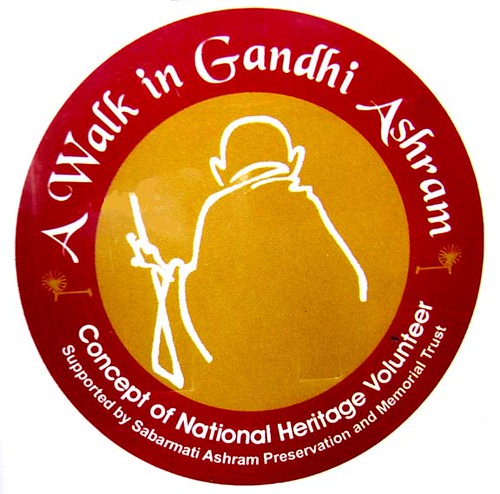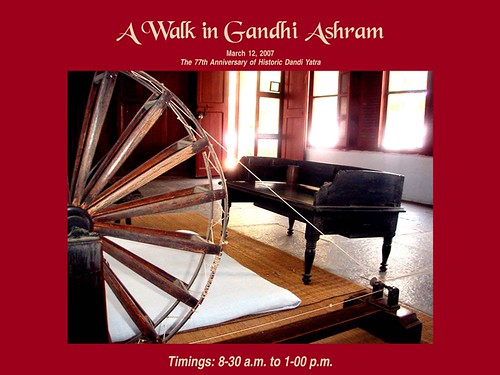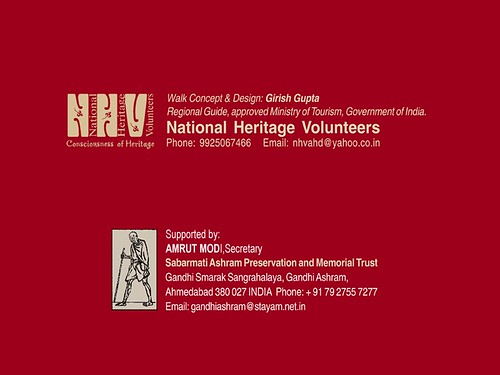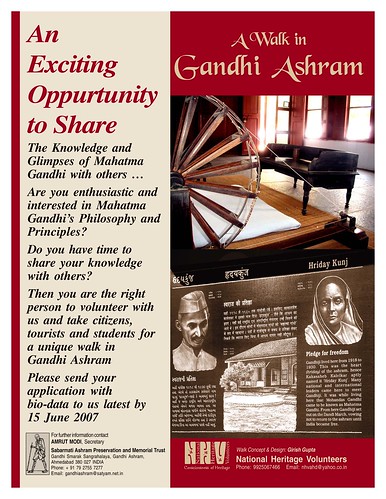Guided Walk available now in Gandhi Ashram, Ahmedabad(Video)
March 12, 2007
Ahmedabad, DeshGuajarat
Ahmedabad based National Heritage volunteers has initiated “A walk in Gandhi Ashram” from 12th March 2007 in Sabarmati Gandhi Ashram of Ahmedabad. This guided walk will cover all aspects of Sabarmati Gandhi Ashram. Walk will take place daily morning from 8.30 A.M. to 1.00 P.M.
Walk will start with a brochure and slide-show along with commentary. Brochure has brief history of Sabarmati Gandhi Ashram along with it’s detailed map. Starting from Magan Nivas(Magan’s residence) and passing through Upasana Mandir(open space for prayer), Hriday Kunj(Gandhiji’s residence), Vinoba-Mira kutir(Where Vinoba and Madeline Slade(Miraben) used to stay at different interval, Nandini( A guest house of Ashram where many national and international dignitories stayed), Udyog Mandir, Somnath chhatralaya, Teachers’ Niwas and will end at Gandhi museum-library-painting gallery. Contact Girish Gupta for more detail: His Mobile no. is 9925067466. Email: nhvahd@yahoo.co.in

(Can’t read details properly? For detail view image of brochure make a request to us)





Upon returning from South Africa on January 9, 1915, Mohandas Karamchand Gandhi was in search for a place to settle himself and a small group of relatives and associates who were with him in the African struggle. His political views still unformed, Gandhi chose Ahmedabad in the West Indian state of Gujarat for three reasons, ” being a Gujarati, I’ll serve my country best through the use of the Gujarati language. As Ahmedabad was the center of the handloom in early days, the work of spinning wheel (charkha) could be done in a better way, I believed. Being the capital of Gujarat its wealthy persons will also make a larger contribution, I hoped,” in his own words.
Gandhi first created Kochrab Ashram, which was located in proper Ahmedabad city; however, in 1917 an epidemic plague broke out that forced them to leave the site. Several visits were made to the Sabarmati sight, which incidentally holds its own glory in Hindu mythology as a famous incident of extreme sacrifice. The land was far from the city of Ahmedabad, surrounded by jungle full of snakes, and situated along the steep rugged cliffs of the Sabarmati River. Nearby, was a British Prison filled with the sounds of iron chains of the inmates engaged in manual labor. Thunder, lightening, and heavy rains marked the day of Gandhi’s final decision.
He said, ‘ This is the right place for our activities to carry on the search for Truth and develop Fearlessness – for, on one side, are the iron bolts of the foreigners, and on the other, thunderbolts of Mother Nature.”
Gradually a few dwellings were built, simple but efficient, on the 36 acre Ashram site and activities were begun. The Ashram was a human laboratory where Gandhi could test his moral and spiritual hypotheses. It was a family not linked by blood or property, but by an allegiance to common ideals. These main objectives of Sabarmati were as follows: Education, Truth (Non-Violence and Love), Celibacy, Control of the palate (no liquor or meat), No Stealing, Non-Possession (simple living high thinking), Use of home-made articles, Conquer of Fear, and the eradication of UNTOUCHIBILITY.
The first struggle Gandhi headed from the Sabarmati Ashram was for the textile workers strike. There was a complete deadlock between the mill owners and the inadequately paid workers. It was difficult for the workers not to become angry, as they were starving. However, Gandhi joined with them in fast, and later used the strikers to found a Weavers School at Sabarmati.
Gandhi’s charkha and untouchability campaign brought the majority of the deprived masses of India into the national mainstream. Also during his time at Sabarmati, Gandhi was jailed for 6 years in the nearby prison and published his now famous autobiography, “My Experiments With Truth”, after his release.
The most famous and epic chapter of the Sabarmati Ashram came in the way Gandhi bid farewell to it. On March 12, 1930, directed by his ‘inner voice,’ Gandhiji embarked on a 240 mile walk with 79 selected followers to break the Salt Tax, imposed by the British. This, known in history as The Dandi Salt March, united the country and set into motion the events that would later free a nation. Gandhi was no longer referred to as Mohandas, but as Mahatma, or ‘Great Soul.’ Gandhi has said he would never return to Sabarmati until India achieved Independence. He did, though on a somber note, see India gain Independence on August 15, 1947; but was unable to return to Sabarmati, as he was assassinated by Vinayak N. Godse, a staunch Hindu fanatic, on January 30, 1948. India’s Independence had divided its people into two nations; India and Pakistan. It was for this reason Gandhi sought no celebration on August 15th, and it was his avocation of Hindu-Muslim unity that finally ended his life.



Recent Stories
- Felicitation of Jaysukhbhai Patel sparks controversy
- MBBS first year student dies due to alleged ragging by seniors in Patan
- Gujarat CM makes allocation for widening of roads
- Gujarat CM inaugurates Virasat folk art museum at Akru
- Shah to open Sabar Dairy's Cattle Feed Plant on Nov 19
- One held in Surat for circulating anti-Hindu pamphlets aimed at defaming son-in-law
- Ensure Effortless GST Compliance and Simplify Your Business with Vyapar App’s Billing Software

